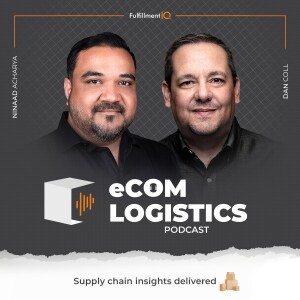
How to Automate Warehouse Picking and Packing for Logistics with Simon Kalouche
 2023-06-22
2023-06-22
In this episode, Simon Kalouche, founder and CEO of Nimble, joins the hosts to discuss the future of ecommerce logistics and the role of automation and robotics. Simon emphasizes the importance of automating core warehouse processes while acknowledging the challenges of handling edge cases. He shares his background in robotics and the application of deep learning in the field. Simon also highlights the potential of gecko adhesive technology for gripping and handling objects in logistics. The conversation explores the need for warehouses designed for robots and the vision of creating fully autonomous warehouses. Simon concludes by emphasizing the value of human involvement in the evolving landscape of ecommerce logistics.
ABOUT SIMON
Simon founded Nimble in 2017 after dropping out of his PhD at Stanford. He's spent the last 5 years inventing and scaling intelligent next-gen autonomous logistics systems. Previously Simon led development of dynamic legged robots for the Department of Defense while completing his masters in robotics at Carnegie Mellon, International Space Station robots for NASA's Jet Propulsion Lab and autonomous off-road vehicles for the Air Force Research Lab.
HIGHLIGHTS
If you try to automate all the one-offs, your warehouse will end up costing way too much.
There's always edge cases and one-off things you have to solve for in logistics.
Deep Imitation Learning allows robots to learn tasks through human demonstration.
Designing warehouses conducive to robots opens up new possibilities for automation.
The future of ecommerce logistics lies in a balance between automation and human involvement.
QUOTES
Real-World Automation Strategist, Variability Management Specialist. Simon: “I saw an opportunity to deploy this in the real world. There are so many monotonous, repetitive tasks out in the real world that are, you know, that are very repetitive, but yet too hard to automate because there's a lot of variability involved. And eCommerce to film is a classic example, right? If you think about a warehouse. You know, all day long is picking and packing and picking and packing. Uh, but the part that makes that task hard to automate is that you could be picking and packing 10 million or 20 million different objects, right? And every object has a different size and shape and weight and texture and stiffness and something you're fragile.”
Labor Optimization, Warehouse Automation. Simon: “Running a warehouse today is very hard because of the labor problem, right? The, it's, it's very hard to find, to recruit, to train and to retain hundreds or thousands of people. Um, and, and that is what makes a warehouse very challenging to operate. And then when you wanna run a network of warehouses, you're multiplying that challenge by. You know, by the number of nodes in, in your network by three nodes, four nodes, five nodes, you know, whatever it might be. And so that, you know, you're quickly managing thousands of people. It takes a lot of money and, and effort and overhead to manage all of that. If you can automate the warehouses and reduce the amount of labor that's needed, um, you know, by an order of magnitude, warehouses all of a sudden don't become, you know, rocket science, uh, to run, you know, if the robots are working and the, you know, the system is highly automated. You know, the, the warehouse is not that hard to run”
Find out more about Simon in the link below:
LinkedIn: https://www.linkedin.com/in/simon-kalouche-98883343/
More Episodes
Create your
podcast in
minutes
- Full-featured podcast site
- Unlimited storage and bandwidth
- Comprehensive podcast stats
- Distribute to Apple Podcasts, Spotify, and more
- Make money with your podcast
It is Free
- Privacy Policy
- Cookie Policy
- Terms of Use
- Consent Preferences
- Copyright © 2015-2024 Podbean.com






